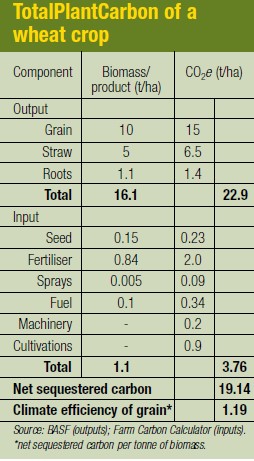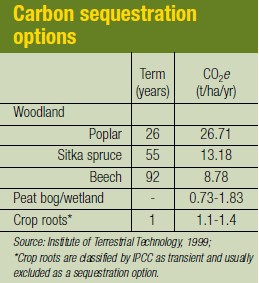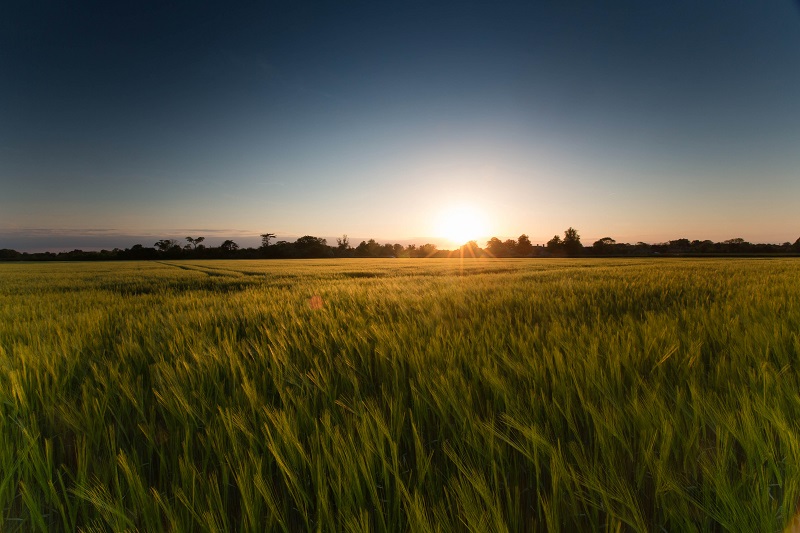Farming captures vast amounts of carbon every year in the crops, grassland and livestock that produce the world’s food, but their contribution to net emissions are entirely ignored. CPM explores how to farm carbon.
Agriculture is so often accused for its negative climate effect, but doesn’t get praise for its positive carbon-binding.
By Tom Allen-Stevens
Imagine if we mined food from depleting resources, in the same way as we source raw materials for our manufactured goods and much of our energy requirements. The world would turn to dust in no time at all.
So thank goodness that food is a basic resource that comes from truly renewable material – perhaps the only one that does. But why is the industry responsible for its production – farming – treated as though it isn’t?
There’s now a growing body of opinion that questions the very basis on which agriculture’s carbon cost has been calculated. The assumption, laid down by the Intergovernmental Panel on Climate Change (IPCC), is that the net flux from agriculture is estimated to be approximately balanced. So carbon sequestered during food production is assumed to be released during the same year when the food is consumed and through residue breakdown.
“But this totally ignores the role of photosynthesis and the farmer’s skill in maximising the efficiency of their crops in using it to capture carbon,” notes Mike Green, BASF UK and Ireland agriculture sustainability manager.
“A better approach is to look at the TotalPlantCarbon sequestered in the crop by the grain, stem and root together. The farmer’s aim may be to maximise the carbon stored by the crop using the most efficient approach. The crop is then massively carbon positive as it sits in the field. The other side of the equation is how it’s then harvested, the TotalPlantCarbon partitioned, and the carbon release of the components accounted for.”
Getting the optimum balance is what BASF calls ClimateEfficiencyMax, and Mike believes this is a far fairer way for growers to strive for a better carbon balance on their farm and one that would ultimately drive the most sustainable form of crop production across the rotation.
The numbers are quite compelling, according to Per Frankelius, associate professor at Linköping University, Sweden. “It’s strange that agriculture is so often accused for its negative climate effect, but doesn’t at the same time get praise for its positive carbon-binding and oxygen production,” he notes in a paper published in Agronomy Journal earlier this year.
According to the IPCC, around 23% of total anthropogenic greenhouse gas emissions (those resulting from human activity) derive from agriculture, forestry and other land use. Agriculture makes up about half of this and global models estimate net emissions of 6.2 Gt CO₂e/yr (gigatonnes, or billions of t of CO₂ equivalence).
But Per’s new preliminary calculations put the total amount captured in growing crops and grassland – excluded in the global models adopted by IPCC – at 39.5 Gt CO₂/yr. This includes an estimated 2.75 Gt of organic carbon left in the field in the form of residues and roots – equivalent to around 10 Gt CO₂.
“Consider a world in which we take all agricultural land away – the climate would quickly hit a catastrophic crisis,” he notes. “What’s more, as well as sequestering carbon, these crops are responsible for generating huge amounts of oxygen, which is good for the climate.”
The argument for not taking harvested products into account as a positive contribution is that the bound C in food will generate CO₂ when it’s consumed. “But that occurs outside the agricultural sector, and at later points in time,” Per points out.
There’s a scientific imperative to recognise this contribution, even if it is temporary, he argues. “Agriculture is already partly a Net Zero hero, but we can do more to boost its climate contribution – we can enhance our environmental assets, through innovation”, he says.
“But as a result of the IPCC paradigm Europe has mostly focused on methods of reducing emissions, while there are excellent ways to enhance photosynthesis, such as genetic advances, with the potential to improve plant biomass and therefore both carbon binding and oxygen production.”
Per is concerned that agricultural productivity advances are perceived as mostly negative as a result of the IPCC’s failure to recognise the true value of photosynthesis, suggesting a connection between that perspective and EU policy-making. “If this is the case, there will be fewer incentives to support productivity – the EU’s Farm to Fork and biodiversity strategies are examples of policy pulling partly against productivity.”
A recent analysis by the US Economic Research Service, for example, has found these policies would result in EU production falling by 7-12%, reducing worldwide societal welfare by $96 billion to $1.1 trillion, depending on how widely other countries adopt the strategies.
“If the EU and others really want to meet multiple challenges successfully there is only one pathway: radical innovation,” states Per. “In the US, agriculture is embraced as the country’s most important industry. Agtech innovation takes centre stage and Silicon Valley has contributed in creating amazing technology for the American farmer.
“But in the EU, agriculture has become considered as a climate villain, and that can lead to new regulations that inhibit production levels and profitability of farming, and these in turn can be very damaging from a broad sustainability point of view.”
Quite where climate policy in relation to agriculture will go in the UK is still unclear. Raising productivity is one of the three core pillars behind NFU’s policy ambition for UK farmers to reach Net Zero emissions by 2040 and could deliver around a quarter of net savings.
But NFU combinable crops board chairman Matt Culley is concerned policy-makers at the very highest level can’t think further than planting trees as the sole solution for climate change. “NFU supports tree-planting in areas identified as having low productive capacity. But I’m really keen to see a whole carbon supply chain develop, that recognises all of the carbon captured by crops and where it then goes,” he says.
“Farmers have no control over how the captured carbon is released, but can do so much to enhance the efficiency of how they sequester it. Meanwhile, I’m convinced if this carbon is given a value, the supply chain will rise to the challenge of bringing it to the end user in the most efficient way, while the carbon efficiency of imports will get proper scrutiny. It’s up to negotiation as to how this carbon value is shared, and how much it’s actually worth, but it would be a real and compelling incentive for growers to focus on their carbon footprint.”
 So how would this work on farm? It’s an area BASF has been developing, working with other partners in the supply chain, Mike explains. “If you take a crop in a field as the unit, pre-drilling you have a negative carbon balance, embedded in the input CO₂e ‘debt’ of the products you have sitting in your shed – seed, fuel, crop protection, fertiliser.
So how would this work on farm? It’s an area BASF has been developing, working with other partners in the supply chain, Mike explains. “If you take a crop in a field as the unit, pre-drilling you have a negative carbon balance, embedded in the input CO₂e ‘debt’ of the products you have sitting in your shed – seed, fuel, crop protection, fertiliser.
“Once the crop is growing, you start to reduce this debt as your solar panel crop sequesters more CO₂e into TotalPlantCarbon, although you must also debit input CO₂e of fuel and machinery and your establishment technique.”
Just before harvest, you assess TotalPlantCarbonMax for that year (see worked example on left), that takes account of the total biomass you have accumulated. “But of course, we harvest the crop, partitioning off the grain and straw components, leaving behind the roots and stubble.”
The grain isn’t stored on farm forever, though, so you would lose that element of the TotalPlantCarbon when you sell it. “But the Input CO₂e debt apportioned to the grain should go with it. That leaves up to 34% of the carbon remaining on the farm, depending on what you do with the straw. Once you’ve factored in the remaining input CO₂e, that means a considerable net amount has potentially been sequestered.”
Mike argues that calculating net emissions in this way, using TotalPlantCarbon, allows greater leeway for growers to aim for ClimateEfficiencyMax – the maximum net sequestered carbon per t of produce. This could then become a tradeable premium commodity, like grain protein and oil content. “Those growers particularly proficient at using their solar panel crop to sequester carbon will become sought after by end users as the grain will carry with it a proportionately higher carbon credit.”
In terms of the carbon residue left on farm, crop roots and incorporated straw can be captured into soil organic matter, although Mike notes that maybe 50% will naturally break down and be lost to CO₂ during the year.
None of this carbon is currently accounted for in any of the carbon-accounting tools available, explains Becky Willson of Farm Carbon Calculator. “The IPCC currently takes the carbon captured by the crop as transient, so it’s accruing in the system no faster than it’s being released.
“However, the nitrous oxide (NO₂) emissions lost from crop residues during breakdown are accounted for as a significant CO₂e loss, even though the carbon captured isn’t credited while the crop’s growing.”
The rate at which these emissions are released is dependent on cultivation, fertiliser practice, soil type and conditions, with CO₂e emissions from plough-based systems being the highest. “The way tools account for these losses are being refined as we learn more about the management practices that can be used to mitigate them,” she adds.
On the crop input side, growers are penalised for emissions, although this doesn’t fully account for efficiency of use. “Fertiliser makes up 50-60% of total emissions for an average arable farm, but growers don’t see the carbon benefit. You can measure your emissions intensity – total emissions per tonne of produce – but this doesn’t fully reflect carbon captured during crop growth.”
Becky notes that aspects such as fertiliser timing can have a massive influence on biomass growth and therefore carbon sequestered, but this won’t be reflected in a farm’s net emissions. “Use of crop protection products is potentially an even greater anomaly – they make up less than 1% of overall emissions, yet a good fungicide, for example, can improve plant health and therefore the carbon efficiency of a crop.”
So should the carbon captured in crops make a contribution to a farm’s net emissions balance? “It’s not too difficult to put figures on it, and there’s certainly potential to then use those figures to improve the carbon efficiency of a crop production system,” she says.
“Care would have to be taken with how the figures are used – sequestered carbon only makes a difference to climate change if it is permanently captured, while a crop will take carbon out of the atmosphere for no more than two years before it’s released again.

“That said, the carbon captured by trees may be significant, but doesn’t take account of what happens once a woodland planting reaches maturity, which can be in as little as 20-30 years. So it seems a little unfair to give all the credit to trees – in the right place and right situation they are a useful tool, but they are not the only option.”
How to boost soil carbon
Time since last tillage has a direct effect on soil organic carbon (SOC) status, while it takes around 20-30 years of no-till for a soil to reach its carbon saturation level. These are two major findings of a study carried out in southwest England with the Tamar Valley Organic Group of growers, funded by Westcountry Rivers Trust.
“The growers wanted to know if their soil carbon had a value, while flooding and water quality have been big issues in the area,” explains Soil Health Expert Prof Jenni Dungait.
The study investigated how SOC relates to land use across the 15 farms with samples compared all taken from similar clay-rich soils. Four different land uses were looked at and the farmers asked to supply field history.
“SOC varied significantly with land use and time since last tillage – it’s rare to get such a consistent relationship,” notes Jenni. “Woodland at 5.0% SOC was roughly the same as permanent pasture (4.3%). Then grass ley/arable rotation (3.2%) was similar to arable (2.7%).”
A soil slake test, developed by Dr Sarah Collier who works with US growers, was used as an easy method to quickly assess soil behaviour, and results correlated closely with SOC.
“Management practice does influence SOC and growers can build it,” concludes Jenni. She has some key tips for carbon enrichment:
- Maintain a green cover. Soils don’t like to be bare, so try to keep a root growing through them throughout the year – cover and catch crops help here. These will also add to SOC, as will additions such as farmyard manure.
- Address compaction issues. These can make a massive difference to net emissions. Use a spade to make regular inspections and address problem areas with appropriate cultivation – roots can’t do this on their own. Aim to lift compacted layers, putting in vertical fissures. Then, look after the structure – don’t smash it up or traffic soils in the wet.
- Keep the surface alive. A thick mat of straw will bury the microbes, so even just a light pass with a straw rake can help crop residue mix with the soil. This gets the carbon cycle going.
- Consider multi-canopy cropping. Agroforestry is a good way to capture carbon into your soil while retaining the land for food production. Tree roots benefit from active management, as well as the canopy – if encouraged to go deep they won’t interfere with the crop and can help maintain soil moisture.
“It’s worth noting that a healthy carbon-rich soil is dynamic, so good management is not about locking up carbon, but invigorating the soil community and encouraging the carbon cycle,” adds Jenni.
Sustainable Gain
Leaving the land in a better state than we found it unites progressive arable farmers and policy makers in a common aim. But it’s not so easy to put into practice, treading the delicate balance between bounty drawn from the land, an innate care for Nature’s needs and the moving sands of societal demands.
CPM is working with some of the industry’s leading companies to sort the soil sense from the climate guff. These articles bring the inside track on policy as it evolves, delve into the opportunity and pinpoint the potential for long term sustainable gain.
BASF knows that for farmers, preserving the land is common sense: for their businesses, for their communities and for the next generation. They can rely on the support of BASF with innovative products and agricultural solutions that also reach far beyond standard crop protection.




